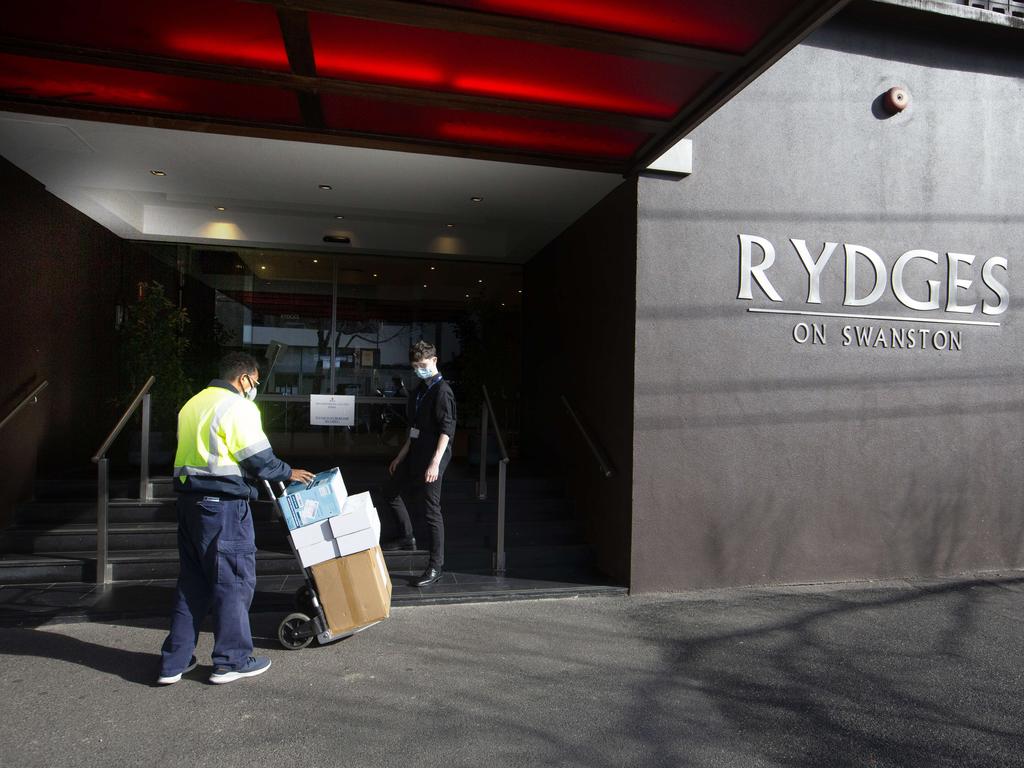
The first issue is whether the Victorian government will do to plaintiffs what West Australian Premier Mark McGowan has done to Clive Palmer — legislate a victim’s legal rights away. The stakes are the same: lawsuits that threaten major damage to a state economy. That’s the single justification McGowan has used to strip basic legal rights from Palmer.
A few weeks ago Palmer hung up during an interview with ABC radio host Hamish Macdonald, labelling his questions “bullshit”.
Palmer was right. It wasn’t the sharpest interview. Macdonald grilled Palmer about taxpayers footing the damages bill if the businessman wins in court. Hold the presses: Taxpayers get stuck with the bill when governments lose in court! Will Macdonald and other media outlets be equally fixated on the taxpayer purse in the case of people damaged by the negligence of the Victorian government?
The second, far more fascinating, question will be which law firm races to sign up a lead plaintiff so they can launch this class action against the Andrews government. That’s all it takes: find one lead plaintiff, have a belief there are seven others — then, using a neat process open to class action lawyers, many thousands of other people become part of the case unless they opt out.
Watching which law firm will launch class actions against the Andrews government will be a curious spectacle given Victoria’s new legal environment where lawyers can charge contingency fees; in other words, securing a percentage of the settlement.
In the legal world, nothing is sexier than scoring the biggest, most lucrative and high-profile class action. Normally, Australia’s prominent class action law firms, Maurice (“we fight for fair”) Blackburn and Slater & Gordon, would be tickled pink by the prospect of a negligence claim seeking billions of dollars from a powerful institution. Except this time lawyers at Maurice Blackburn and Slater & Gordon may not be dusting off their Mother Teresa outfits. Instead, they may have the mother of all conflicts.
It’s on the public record both firms, especially MB, are large donors to the Victorian ALP and have significant personal links with key ALP figures. Some cynics have even suggested these links helped convince the Victorian Labor government to legalise contingency fees despite concerns from the Law Council that lawyers taking a direct cut of a settlement causes them irreconcilable conflicts of interest with plaintiffs.
Could plaintiffs be sure a law firm’s ALP links will not cloud the judgment of how it runs the case or gives advice on any proposed settlement? Even if political donations and personal links aren’t enough to create a disqualifying conflict of interest, consider the wider conflicts caused by the mouth-watering amounts of money involved.
A successful claim for, say, $10bn could yield the winning law firm perhaps $2bn or $3bn in contingency fees, after all expenses have been paid. Divide that among the partners of Maurice Blackburn, Slater’s or any other law firm. It would take them from being merely Porsche-driving denizens of Toorak and Portsea to the world of mega yachts and Monaco.
And if the Victorian Labor government offers a low-ball bid, say $6bn or $7bn, to settle quickly, effectively using taxpayer money to avoid lingering political and reputational pain, this is still a huge return for the lawyers. They might need to downgrade slightly, from Monaco to St Tropez or Cannes. The upside of an early, quick and lower financial settlement is they avoid the cost and risk of running the case.
Given the sums involved, it must be tempting for class action lawyers to do even a little of what litigation funders do right now: act according to what’s best for their business, not what’s best for plaintiffs. This issue is heightened because returns to contingency fee lawyers will mirror those to litigation funders. Calculated as a percentage of the winnings means the returns are entirely uncorrelated to the amount the law firm or funder has invested in the case or the risks they run.
This kind of uncorrelated return is the Holy Grail of investment firms. It explains why the world’s hedge funds and pension funds, as well as a motley crew of get-rich-quick shysters, have been flocking to litigation funding firms here.
In 2018, Shine Lawyers class actions team leader Jan Saddler said the firm was “very keen” to grow its shareholder class action practice. “We want to be a big player in this area,” she said. Imagine the eagerness now.
In every other asset class, investor returns are a function of the amount they have invested, the duration of the investment, with the percentage return dialled up or down by reference to the perceived risk of the investment.
Even better for the class action sharks and gamblers, in Australia the spectacular riches have been inversely proportionate to the consumer protection regulation offered to potential plaintiffs.
The business case is simple: huge pay-offs plus bugger-all regulation equals Nirvana.
Not only is there no regulation around methodology of charging fees, there has been no regulation requiring full disclosure of a scheme to potential plaintiffs, no requirement of informed consent from class members in advance, no proper regulation of conflicts of interest, and no attempt by regulators to gauge the grand “access to justice” promise of litigation funders and class action-chasing lawyers.
As of last Saturday, litigation funders are required to hold an Australian Financial Services Licence and issue product disclosure statements for litigation funding schemes. Litigation funders, and law firms threatened with similar regulation, are whinging that it’s all too complex. It’s like listening to Al Capone complain that law gets in the way of a good shakedown. Hire a lawyer. Figure it out.
The only semblance of regulation has been by the judiciary, but they often don’t call in a contradictor to properly assess claims. Contingency fee lawyers and litigation funders want to keep the judges as their regulator of choice because they are no substitute for a decent regulator.
A court approved $17m in costs and commission in a $64m settlement in the long-running Banksia Securities case. Fraud at the centre of this scandal was discovered only because one brave plaintiff opposed that settlement. The admission by Victorian silk Norman O’Bryan and junior counsel Michael Symons that they exploited the class action litigation to inflate their legal fees is not just a spectacular fall from grace for those lawyers but also a calamity for the plaintiffs. But lax regulation and high returns attract cowboys and crooks.
So to go back to where we started. For Victorians damaged by the Andrews government’s handling of COVID-19 quarantine, class action lawsuits where lawyers charge contingency fees won’t be in the best interests of plaintiffs. But it will be a new goldmine for the lawyers. Enough to keep them sending grateful donations to Labor for years.





The prospect of COVID-19 lawsuits against the Victorian government for its shockingly negligent handling of hotel quarantine showcases the toxic mix of problems facing plaintiffs in class actions in Australia.